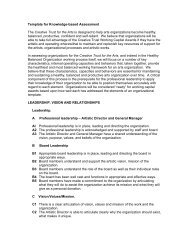20 Questions - Canadian Institute of Chartered Accountants
20 Questions - Canadian Institute of Chartered Accountants
20 Questions - Canadian Institute of Chartered Accountants
You also want an ePaper? Increase the reach of your titles
YUMPU automatically turns print PDFs into web optimized ePapers that Google loves.
8. How much risk is appropriate?<br />
Effective organizations recognize that they must take advantage <strong>of</strong> opportunities<br />
to improve service to stakeholders and they also understand their “risk tolerance”<br />
– the amount and types <strong>of</strong> risk they are comfortable in assuming. Boards <strong>of</strong> directors<br />
must make sure that their organizations “optimize” risk by balancing risk and<br />
opportunity in accordance with risk tolerance levels approved by the board.<br />
The decision to adopt a strategy should include discussing:<br />
• Is this the best use <strong>of</strong> our resources?<br />
• Are we comfortable with the risks involved?<br />
“Nothing ventured, nothing gained” and “playing it safe” are two approaches to<br />
risk that can divide boards <strong>of</strong> directors and lead to long debates. The “venturers”<br />
see taking risks as the best way to succeed. The “play-it-safers” fear that<br />
risky strategies could destroy an organization that knows its limitations and<br />
does a good job <strong>of</strong> meeting its modest objectives.<br />
The board is responsible for approving the balance between the two approaches<br />
and providing strategic guidance and direction to staff. This may involve considering<br />
the spirit and attitudes <strong>of</strong> the members, stakeholders, board and staff<br />
and the values <strong>of</strong> the organization.<br />
A related factor is the organization’s “capacity for risk”: the strength <strong>of</strong> its<br />
finances, donor support, reputation and credibility, and the experience and<br />
competence <strong>of</strong> volunteers and staff.<br />
The board may choose to discuss and approve risk factors on an unstructured,<br />
case-by-case basis, or to approve a formal “risk tolerance” policy. In either case<br />
it is valuable to record the discussion and decision for future reference.<br />
The main points to consider in risk-tolerance discussions and policies are:<br />
• The amount <strong>of</strong> money that the organization is prepared and able to lose if a<br />
strategy or project is less successful than anticipated: e.g. What would happen<br />
if a fund raising project loses money?<br />
• The potential risk to the organization’s reputation and credibility if a strategy<br />
or project is poorly received or otherwise unsuccessful.<br />
• The limits <strong>of</strong> the authority <strong>of</strong> the Executive Director or CEO – beyond<br />
which board approval is needed.<br />
• The information the board should receive before making its decision to grant<br />
approvals.<br />
Recommended practices<br />
• The organization’s risk tolerance policy provides a balance between too<br />
much and too little risk taking<br />
• The risk tolerance policy is consistent with the organization’s capacity for<br />
taking risk<br />
• The board approves the risk tolerance policy and reviews it at least annually<br />
Risky business<br />
Fund raising projects such as lotteries, golf tournaments, cruises,<br />
etc don’t always make money. Prizes, advertising and administration<br />
can be expensive. Public support is not automatic – particularly<br />
when there are popular competitors. The same can be true for<br />
“blockbuster” exhibits at museums and art galleries.<br />
Major fund-raising events and ambitious building projects are<br />
examples <strong>of</strong> concentrating risk into one big initiative that can bring<br />
success and recognition but requires confidence, competence,<br />
sustained dedication and an appetite for risk.<br />
Organizations with a lower tolerance for risk may have the capacity<br />
but not the appetite for big risky ventures.<br />
11












